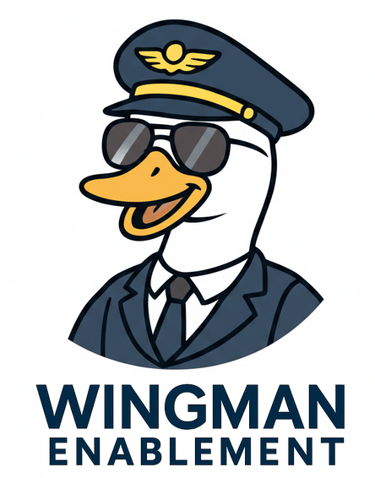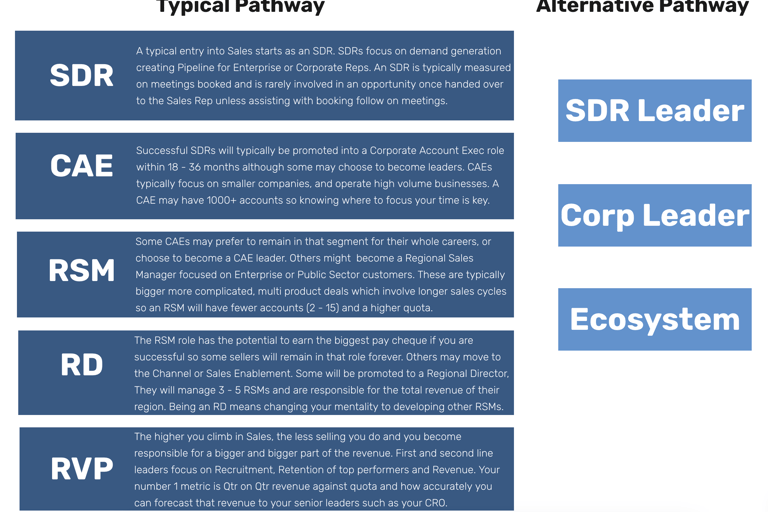Getting Started in Software Sales
It starts with Your Why? Travel, Money, Variety, Career Progression can all be achieved through becoming a Software Seller. But it is also hard work, long hours, high pressure and there will always be challenging times. Being a Sales Professional is not for everyone, but with the right attitude, a good work ethic, the right mentors and enablement, it might be the perfect choice for you. Add in a great product to sell, and the opportunities really are limitless.
So where do you start? There was no class in High School that taught Sales despite it being a time-honoured career. With no clear entry pathway, you need to find your own start. That start in Software Sales will typically either be in a related role, such as being a Recruiter, starting at the very bottom of the sales tree as a Sales Development (SDR) or Business Development Representative (BDR), or in a sales role that has a traditionally lower barrier to entry (shop based, consumables, etc) before moving into more complicated sales motions once you have demonstrated a track record of repeated success and over achievement against targets. Once in a sales team, it is also sometimes possible to move into a quota carrying sales role. This would typically be a pathway a Sales Engineer (SE) would take, and many highly successful Field Sales Reps (FSR) / Regional Sales Manager (RSM) started life as a technical peer.
We will focus on the SDR/BDR pathway, where the term is often interchangeable however the two roles are subtly different with SDR's typically focused on inbound leads (following up on marketing leads including where a prospect has entered details on the corporate website) whereas BDR's will be driving outbound pipeline generation through emails, cold calling and other mediums.
It is important to understand each roles responsibilities within a Sales team and what progression would look like.
SDR
CAE
RSM
RD
RVP
SDR Leader
Corp Leader
Ecosystem
A typical entry into Sales starts as an SDR. SDRs focus on demand generation creating Pipeline for Enterprise or Corporate Reps. An SDR is typically measured on meetings booked and is rarely involved in an opportunity once handed over to the Sales Rep unless assisting with booking follow on meetings.
Successful SDRs will typically be promoted into a Corporate Account Exec role within 18 - 36 months although some may choose to become leaders. CAEs typically focus on smaller companies, and operate high volume businesses. A CAE may have 1000+ accounts so knowing where to focus your time is key.
Some CAEs may prefer to remain in that segment for their whole careers, or choose to become a CAE leader. Others might become a Regional Sales Manager focused on Enterprise or Public Sector customers. These are typically bigger more complicated, multi product deals which involve longer sales cycles so an RSM will have fewer accounts (2 - 15) and a higher quota.
The RSM role has the potential to earn the biggest pay cheque if you are successful so some sellers will remain in that role forever. Others may move to the Channel or Sales Enablement. Some will be promoted to a Regional Director, They will manage 3 - 5 RSMs and are responsible for the total revenue of their region. Being an RD means changing your mentality to developing other RSMs.
The higher you climb in Sales, the less selling you do and you become responsible for a bigger and bigger part of the revenue. First and second line leaders focus on Recruitment, Retention of top performers and Revenue. Your number 1 metric is Qtr on Qtr revenue against quota and how accurately you can forecast that revenue to your senior leaders such as your CRO.
Typical Pathway
Alternative Pathway
What is a Territory?
Each seller (CAE, RSM etc) will be assigned a territory, containing named accounts. A territory will have been defined by Sales Ops and/or your Regional Director based on the total addressable opportunity believed to contained in those accounts. A well planned territory should allow a capable RSM to meet and overachieve quota.
It is worth noting that accounts contained within a territory may be assigned to an RSM, but they do not belong to that RSM. Accounts and territories are subject to change, so accounts may be reallocated (either moved between segments or to another territory). This is especially likely to happen if the account is cold, meaning the RSM is not actively working opportunities.
A territory might be as small as 1 account, or as large as several thousand depending on the anticipated opportunity contained within each account and the assigned RSM quota.
Territories typically have a mix of existing customers and prospects, providing both upsell and new logo acquisition opportunities. Other territories might be determined by industry segment (FSI, Healthcare, Government), or designed to suit specific strength of the sales team, hunters or farmers. Hunters specialize on new logo acquisition whilst farmers focus on upsell and longer term relationship building.
Not all territories are created equally (although they should all contain similar potential). A good territory, filled with ICP customers is a far smoother pathway to meeting or exceeding quota.
In most companies you will only get paid on opportunities closed within. your assigned territory. DO not be tempted to work on deals for unassigned accounts without first gaining agreement with your sales leaders. Whilst it might benefit your employer, and your customer, it may not retire quota.
Takeaway:
You may not always be able to influence which accounts fall into your territory, but you can control how you attack the accounts you have. A poorly designed territory will make selling harder, but if selling was easy everyone would do it and you would not be getting paid the rewards you are. Building a plan, testing and disproving Pain Hypothesis and demonstrating back to your sales leadership that there is no opportunity might assist getting additional accounts added to your territory. Complaining because you do not have your preferred accounts will not help anyone.
What is a Quota?
A quota (or plan) defines the expectations your sales leaders have for you for a period of time. This will typically be annual, but with quarterly attainment targets that often increase across the year. It defines success, and is the standard against which performance is measured. Quota is the justification of your salary, incentive to sell and how additional seller headcount is funded by the business. Sellers compensation, on target earnings (OTE) is typically broken into two halves. The first half is base salary payable for you to meet the general obligations of your role. The second half is commission based upon sales performance. Achieving 100% of your quota means achieving 100% of your OTE. Additional sales within that period, typically the quarter, retires quota at an accelerated rate known as accelerators.
Quota is allocated at each level in your sales organization from individual contributor to sales VP. At an individual level, your own sales success defines you attainment against quota, but as you move into leadership, your own quota is allocated across the individual sellers within your team.
Quotas should be realistic, designed to encourage hard work without excessively rewarding sellers at the expense of company profit. Set the quota too low and everyone makes plan costing the company profit. New sellers joining a team will typically get some sort of relief from quota as they are ramping into the company meaning. they are not expected to contribute revenue as much as an established seller and will get more recognition for deals closed during that ramp quota period.
When an opportunity in your assigned territory, you will retire quota as a % of the deal value. Quota retirement will vary across companies and the deal structure, but in SaaS companies New Platform Annual Contract Value will normally retire the most quota as it is the metric SaaS companies are measured against and therefore is the behaviour they wish to incentivize.
Depending on the segment, average deal size and constitution of opportunities Quota will vary greatly. IT / Network Hardware companies that deal with major scheduled infrastructure refreshes may allocate very large individual quotas (multi million $), whereas SaaS startups or corporate sales teams may have more modest quotas ($500k - $800k) designed to encourage the new logo acquisition necessary to showcase growth to investors. Enterprise sellers in established SaaS companies might expect $1 - $1.4m).
Takeaway:
Every territory is different meaning even within the same team, different RSMs may carry different quota. Quota, and specifically the over-achievement of quota, is the vehicle by which sellers can make life changing money. It is why people are drawn to sales and the thing that continues to motivate sellers through the hard times.
As a new seller, it can be easy to focus on OTE as the sole measure of compensation. Experienced sellers know quota is the metric by which financial success is actually measured. A lower OTE with achievable quotas and strong accelerators will often result in a greater pay cheque than a higher OTE that is only unlocked through an unreasonably high quota.
Ask your prospective employer how many sellers make quota on average each quarter before you jump into any sales role.


